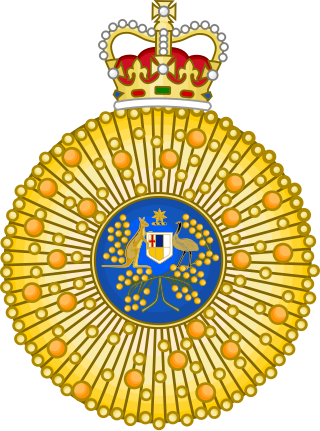
The Order of Australia is an honour that recognises Australian citizens and other persons for outstanding achievement and service. It was established on 14 February 1975 by Elizabeth II, Queen of Australia, on the advice of the Australian Government. Before the establishment of the order, Australian citizens received British honours.
The Australian honours and awards system refers to all orders, decorations, and medals, as instituted by letters patent from the Monarch of Australia and countersigned by the Australian prime minister at the time, that have been progressively introduced since 14 February 1975. The Australian honours and awards system excludes all state and local government, and private, issued awards and medals.

The humanitarian response to the 2004 Indian Ocean earthquake of a magnitude of 9.1 was prompted by one of the worst natural disasters of modern times. On 26 December 2004, the earthquake, which struck off the northwest coast of the Indonesian island of Sumatra, generated a tsunami that wreaked havoc along much of the rim of the Indian Ocean. Particularly hard-hit were the countries of Indonesia, India, Sri Lanka and Thailand. About 230,000 people were killed, tens of thousands more were injured, and 1.7 million became homeless and displaced.
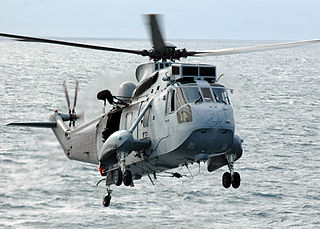
The 2005 Nias Island Sea King crash was the crash of a Royal Australian Navy (RAN) Westland WS-61 Sea King helicopter of 817 Squadron RAN at approximately 4 pm on 2 April 2005 with 11 personnel on board. The accident occurred while "Shark 02" was making its approach to land on a sports field located near the village of Tuindrao in the region of Amandraya on the Indonesian island of Nias. "Shark 02" had been providing humanitarian support to the people of the earthquake-devastated region.

Australian Red Cross, formally Australian Red Cross Society, is a humanitarian aid and community services charity in Australia. Tracing its history back to 1923 and being incorporated by royal charter in 1941, Australian Red Cross Society is the national member of the Federation of Red Cross and Red Crescent Societies and part of the International Red Cross Movement. Australian Red Cross is guided by the Fundamental Principles of the International Red Cross and Red Crescent Movement and as such is a non-religious, neutral, impartial and independent humanitarian organisation.
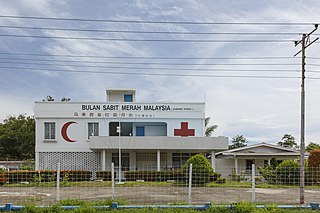
The Malaysian Red Crescent (MRC) is a voluntary humanitarian organization that seeks to promote humanitarian values, as well as provide service and public education in disaster management, as well as healthcare in the community. It is part of the International Red Cross and Red Crescent Movement.
The Governor-General of Australia has, at irregular intervals, notified for general information notifies the positioning of wearing of Australian orders, decorations and medals in the Commonwealth of Australia Gazette. The Order of Wearing Australian Honours and Awards was last published in 2007.
The Australian Sports Medal is an award given to recognise achievements in Australian sport to commemorate Australian participation in major sporting events. Original recipients of the award included competitors, coaches, sports scientists, office holders, and people who maintained sporting facilities and services. During the original period of its award in 2000–2001, over 18,000 medals were awarded. The award was permanently reactivated in 2020 to commemorate Australian contributions and participation in major multi-sport events.
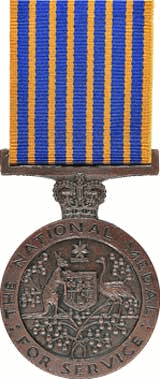
The National Medal is an Australian award given for long service by operational members of specified eligible organisations. It was introduced in 1975, as an original component of the new Australian honours system, and replaced a range of medals available to military and civilian uniformed services for long service and good conduct. The eligible groups have in common that their members serve or protect the community at the risk of death, injury or trauma, hence it is only available to members of the eligible organisations who are operationally deployed. In the case of corrective services, eligibility is restricted to officers with custodial duties.
The Police Overseas Service Medal is an award in the Australian honours system. The award is presented to members of an Australian police force in recognition of service undertaken with an international peace-keeping organisations or following a request for assistance from a foreign government. The award was introduced by letters patent on 25 April 1991. In 2013 the criteria were amended to also include service by regular and patrol officers of the Royal Papua New Guinea Constabulary. Recipients of the medal are not entitled to any post-nominal letters.
The Civilian Service Medal 1939–1945 is awarded to civilians in Australia during World War II who served in arduous circumstances in support of the war effort as part of organisations with military-like arrangements and conditions of service. The medal was introduced in 1994, following a recommendation of the Committee of Inquiry into Defence and Defence Related Awards.

The Australian Service Medal is an Australian military decoration. It was authorised 13 September 1988 to recognise prescribed service in peacekeeping and non-warlike operations. It is awarded with a clasp to denote the prescribed operation and subsequent awards of the medal are made in the form of additional clasps. The Australian Service Medal 1945–1975 recognises non-warlike service prior to February 1975. The Australian Service Medal was replaced in 2012 by the Australian Operational Service Medal, except for ongoing missions.

Malteser International is an international non-governmental aid agency for humanitarian aid of the Sovereign Military Order of Malta. Developed in 2005 from the foreign aid service of Malteser Germany, and having the status of an independent eingetragener Verein since 2013, the agency has more than 50 years of experience in humanitarian relief. It currently implements around 100 projects in some 30 countries in Africa, Asia, Europe, Middle East and the Americas. The organization's General Secretariat is located in Cologne, Germany with regional headquarters for Europe and the Americas located in Cologne and New York City respectively. The membership of Malteser International consists of 27 national associations and priories of the Sovereign Military Order of Malta, who are responsible for supporting the organization within their jurisdictions.
The International Rescue Corps (IRC) is a volunteer organisation involved in disaster rescue, based in Grangemouth, Scotland. Its motto is "United To Save Life".
MERCY Malaysia or Malaysian Medical Relief Society is a non-profit organisation focusing on providing medical relief, sustainable health related development and risk reduction activities for vulnerable communities in both crisis and non-crisis situations. As a non-profit organisation, MERCY Malaysia relies solely on funding and donations from organisations and generous individuals to continue their services to provide humanitarian assistance to beneficiaries, both in Malaysia and internationally. The organisation is a registered society according to the Societies Act 1966 in Malaysia, and the headquarters is in the capital city of Kuala Lumpur.
RedR is an international NGO whose stated mission is to “rebuild lives in times of disaster by training, supporting, and providing aid workers to relief programmes across the world.” It was originally an acronym for Register of Engineers for Disaster Relief, although it is no longer used as such.
The National Emergency Medal is an award of the Australian honours system given for sustained service during a nationally significant emergency; or to other persons who rendered significant service in response to such emergencies. The medal was established by Queen Elizabeth II in October 2011. The medal is awarded for events specifically set out by regulation or may be awarded upon the recommendation of the National Emergency Medal Committee for significant service.
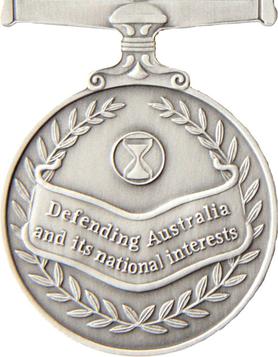
The Australian Operational Service Medal is a campaign medal established on 22 May 2012 to recognise service by Australian Defence Force (ADF) personnel on designated hazardous operations. It may also be awarded to civilians who serve alongside the ADF on designated operations under specific conditions.
The Order of Wearing of Australian honours includes Imperial honours if they were awarded prior to 6 October 1992. Imperial honours awarded after 5 October 1992 are considered foreign.

Alison Thompson is a global humanitarian volunteer and the Founder of Third Wave Volunteers, a United States based nonprofit that responds to disasters and crises around the world. She was born in Sutherland Shire, Sydney, Australia.










